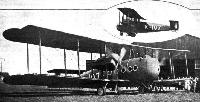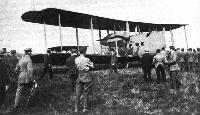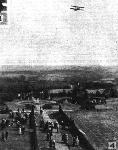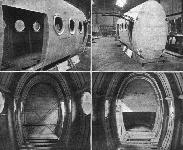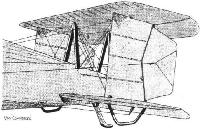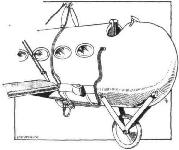В.Шавров История конструкций самолетов в СССР до 1938 г.
"Виккерс-Вернон" - большой пассажирский самолет с двумя двигателями "Нэпир-Лайон" по 450 л. с. с редуктором, 14-местный (12 пассажиров). Фюзеляж - в передней и средней частях, выклеенный из шпона, хвост - каркасный с полотняной обтяжкой, на низком шасси с передним противокапотажным колесом, оперение - бипланное. Был приобретен в одном экземпляре для ознакомления.
Самолет||
Год выпуска||1922
Двигатель , марка|| (2)
мощность, л. с.||450
Длина самолета, м||13,3
Размах крыла, м||21,3
Площадь крыла, м2||27
Масса пустого, кг||4080
Масса топлива+ масла, кг||460
Масса полной нагрузки, кг||1580
Полетная масса, кг||5660
Удельная нагрузка на крыло, кг/м2||44,5
Удельная нагрузка на мощность, кг/лс||6,3
Весовая отдача,%||27,9
Скорость максимальная у земли, км/ч||177
Скорость посадочная, км/ч||91
Время набора высоты||
1000м, мин||7
2000м, мин||15
3000м, мин||27
Продолжительность полета, ч.||2,5
Дальность полета, км||450
Показать полностью
C.Andrews Vickers Aircraft since 1908 (Putnam)
<...>
Height and heat also defeated the other attempt by a Vimy, chartered from Vickers by The Times, with Dr Chalmers Mitchell as their Press representative on the flight. The aeroplane was the prototype Vimy Commercial G-EAAV (originally K-107). It left Brooklands on 24 January, 1920, and crashed at Tabora, Tanganyika, on 27 February, failing to takeoff in tropical conditions. It was found that the water in the cooling system of one of the engines was contaminated. It was clear that further engine and airframe development would be needed to operate in such conditions if the lessons of these African flights were to be fully applied. Judging from the successful use of the Vimy and its family successors in Egypt, the Middle East and India in later years, it seems clear that these troubles in African flying were taken to heart.
<...>
After the Armistice of November 1918, and the rapid cancellation of contracts for military aircraft, the executives of Vickers' aviation started to look around for aircraft projects which might prove attractive in the new world of civil aviation, then thought by many to be just round the corner. Most favoured by Capt Peter Acland, by that time Aviation Department Manager, and by Pierson, was a civil version of the Vimy intended as a passenger carrier for the small private-enterprise airlines about to be formed.
In January 1919 the civil Vimy project, known originally as the Monocoq, crystallised into the design of a new fuselage of generous dimensions to replace the slender bomber fuselage. A forebody of oval cross-section, completely clear of internal obstructions, such as struts or cross-bracing, was joined to the standard rear fuselage, with light fairings attached top and bottom to produce a reasonably streamlined structure, on which the wing cellule, engine mountings and biplane tail of the standard bomber were mounted.
In the forebody wooden box-formers were located on box longerons (to mate with those in the rear fuselage), and the structure was covered with Consuta copper-sewn plywood, the whole comprising a form of stressed-skin construction in wood. Underfloor tanks carried the fuel, which was lifted to service tanks in the upper wing by Vickers' windmill-driven pumps, mounted outboard on the lower centre sections. The longerons aft were of circular section Vickers-Ryan segmented wood type.
Although externally the effect of this large fuselage was not particularly attractive, internally it embodied a spacious cabin capable of carrying 10 passengers in comfort, seated in unstressed leather-padded or wicker chairs. Passenger steps attached to the inside of the rear door, which was hinged at the bottom, added to the modern aspect of the cabin. Regrettably, Vickers' test pilots at Joyce Green refused to consider the neat enclosed flight deck intended to complement the design, saying that vision would be impaired and that they preferred the fresh air of their open cockpits. So the standard cockpit was incorporated as on the bomber, with the eventual change of the captain's seat from starboard (as on the transatlantic Vimy) to port, to comply with the then new air-traffic regulations for left-hand approach circuits as soon as these became mandatory. As in modern practice, by removing the passenger seats, a rear freight space of 300 cu ft could be provided to carry 2,500 lb.
In still air the performance of this Vimy Commercial, as it was eventually named, was slightly in advance of that of the bomber, a bonus probably of carrying stores inside instead of outside; but when adverse winds were encountered its short range was a limiting factor, and with full load a refuelling stop had to be made at a landing strip on the London-Paris route. However, the original concept was sound, and it survived for many years throughout Vickers' range of large military and civil transports up to the Valentia bomber-transport in regular service well into the second world war.
Built in Vickers' aircraft experimental shop at Bexleyheath, the prototype Vimy Commercial first flew on 13 April, 1919, at Joyce Green in the hands of Stan Cockerell. Bearing the interim civil registration K-107, it flew at various presentations of Vickers aircraft, including the ELTA exhibition at Amsterdam. Later as G-EAAV it attempted the flight to the Cape as previously noted.
In 1919 the Chinese Government ordered 40 Vimy Commercials with 35 VIM trainers (converted from surplus wartime F.E.2ds) and 20 reconditioned Avro 504Ks from Vickers, to establish civil aviation in China. The financing of this contract proved difficult, and was eventually arranged by the floating of Chinese Vickers bonds in London. In his book Sagittarius Rising, Cecil Lewis describes his experiences in China with the assembly and flying of some of these Commercials, but most of them appear to have remained in their crates unused.
A production line of Vimy Commercials was established at Weybridge, No. 41 was registered G-EASI and named City of London by its operators, S. Instone and Co, a shipping line pioneering an airline. G-EASI was in service for five years on various European short-haul routes, being taken over by Imperial Airways, which in a later merger of private airlines absorbed Instone's interests. By 1 April, 1924, it had flown 108,000 miles and carried many thousands of passengers.
A Vimy Commercial, G-EAUL, came second in the large aeroplane class of the Air Ministry competitions for civil aircraft in 1920. Another was bought by the French airline, Grands Express Aeriens, for whose service it was engined with Napier Lions and registered F-ADER; but in a modification made at Weybridge later on, it was fitted with 400 hp Lorraine-Dietrich engines.
A Vimy Commercial was also bought by Soviet Russia at about the same time, but no information exists as to its career, except that it was flown in the Moscow region. It combined features of the Instone G-EASI and the later Royal Air Force Vernon and was powered with Napier Lion engines. On delivery, no registration marks were carried. From S. Davis, Vickers' service engineer who went to Russia with this Vimy Commercial and a Vickers Viking IV amphibian, it was learned that the Russians gave him the impression that the acquisition of these aircraft was to familiarise themselves with the latest Western ideas and practices in aeronautics.
In 1921 a military ambulance version of the Vimy Commercial was produced for the Royal Air Force, to carry four stretcher or eight sitting cases, with two medical staff in attendance, the stretchers being loaded through a door in the nose. This was probably the first instance of nose loading. Five of these Vimy ambulance versions were built, powered with Lions, but overseas they did not give a highly impressive performance. One Vimy ambulance (J6904) was fitted with extra wing tanks to Vernon Mark III standard as a reconditioned conversion and others followed.
Vimy (F.B.27 A) Commercial
Accommodation: 2 crew 10 passengers.
Engines: Two 360 hp Rolls-Royce Eagle VIII
Span: 68 ft
Length: 42 ft 8 in
Height: 15 ft 7 1/2 in
Wing Area: 1,330 sq ft
Empty Weight: 7,790 lb
Gross Weight: 12,500 lb
Max Speed: 98 mph at ground level
Climb to 5,000 ft: 28 min
Absolute Ceiling: 10,500 ft
Range: 450 miles
Показать полностью
L.Andersson Soviet Aircraft and Aviation 1917-1941 (Putnam)
Vickers Vimy Commercial (Vernon)
The civil version of the twin-engine Vickers Vimy bomber biplane was a transport with accommodation for a crew of two and twelve passengers. The bulky fuselage was of oval cross-section with an open cockpit on top of the nose section and a twin-fin box-type tail unit. China placed an order for forty, which probably was and continued to be for a long time the largest order for commercial aircraft placed by any operator in the world, one went to France and a few were sold in Great Britain. The type was also acquired by the RAF as the Vernon.
A Vimy transport was acquired by the RKKVF for evaluation together with the Vickers Viking. This machine (c/n 42), which combined the features of both the Vimy Commercial and the Lion-engined Vernon, was delivered in August 1922. It was flown for the first time on 10 August at Khodynka in Moscow by A V Pankrat'ev. During the summer of 1923 it was chartered by Dobrolet for temporary demonstration and passenger fights. It was then transferred from the NOA to the Strel'bom school at Serpukhov and in 1925-26 it served with the 1st Otdel'nyi otryad tyazheloi aviatsii (detached heavy aviation otryad). It was offered to Dobrolet in February 1928 but was rejected and was then written off.
Two 450hp Napier Lion II
Span 21.3m; length 13.3m; height 4.63m; wing area 161 nr
Empty weight 4,080kg; loaded weight 5,660kg
Maximum speed 177km/h; landing speed 91km/h; climb to 1,000m in 7min; endurance 2 1/2 hr; range 450km
Показать полностью
A.Jackson British Civil Aircraft since 1919 vol.3 (Putnam)
Vickers F.B.27 Vimy and Vimy Commercial
<...>
The first prototype Vimy, B9952, with 260 h.p. Salmson engines was allotted markings G-EAAR on 1 May 1919 but these were never carried and during its short career - a flight from Brooklands to Amsterdam in August 1919 for static display at the First Air Traffic Exhibition - wore the constructor’s number C-105. Active flying by the Vickers contingent was done by K-107, the Vimy Commercial prototype which had first flown at Joyce Green on 13 April and used the standard Vimy wing structure and tail unit mated to a rotund, oval section, plywood monocoque front fuselage seating 10 passengers. Entry was via a narrow opening in the port side, closed by a roller blind, and two pilots sat in an open cockpit high in the nose.
<...>
After Martlesham trials the Vimy Commercial K-107 was fitted with rectangular windows replacing the original portholes and an additional door with built-in ‘airstairs’ in the rear fuselage. Carrying the permanent registration G-EAAV, it too left Brooklands for the Cape, a week or so before G-UABA, on 24 January 1920. It was sponsored by The Times and flown by Capts. S. Cockerell and F. C. G. Broome but crashed at Tabora, Tanganyika, on 27 February.
Large scale production of 40 Vimy Commercials for China then began at Weybridge. They inaugurated a mail service between Pekin and Tsinan and two were named ‘Ta Peng’ and ‘Chengku’ but the majority remained in their crates unused. The 39th was allotted, but never used, the registration G-EAUY and the 40th, G-EAUL, was runner-up in the Air Ministry’s Heavy Commercial Aeroplane Competition at Martlesham in August 1920 flown by Capts. Cockerell and Broome.
British air transport pioneers S. Instone and Co. Ltd. took delivery of the 41st Vimy Commercial G-EASI, named ‘City of London’ for its inaugural flight from Croydon to Brussels with jockeys on 9 May 1920. This aeroplane, Vickers Type 66, was the best known of all pre-1939 passenger aircraft, flying continually, almost relentlessly, on the Paris, Brussels and Cologne routes piloted by F. L. Barnard, G. J. Powell and others. As early as July 1921 it had completed 360 hr. flying and had carried 10,600 passengers, many on pleasure flights, and when handed over to Imperial Airways Ltd. on 1 April 1924, had flown 107,950 miles. It was scrapped in 1926 but the inimitable K.L.M. representative at Croydon, Spry Leverton, acquired the cabin as a summer house in the garden of his house in Waterer Rise, Wallington, where it was finally burned in 1935.
The 42nd aircraft, shown at the Paris Aero Show in November 1921 in Grands Express Aeriens livery as F-ADER, later returned to Brooklands to be re-engined with 400 h.p. Lorraine-Dietrich units and left again for Paris in June 1922. This and the 43rd machine, supplied to Russia in September 1922, were similar to the R.A.F. Vickers Vernon, with Napier Lions faired into the lower mainplane.
<...>
SPECIFICATION
Manufacturers:
Vickers Ltd., Vickers House, Broadway, Westminster, S.W.l; Brooklands Aerodrome, Surrey and Joyce Green Aerodrome, Kent.
Power Plants:
Two 360 h.p. Rolls-Royce Eagle VIII.
Dimensions:
Span, 67 ft. 2 in.
Height, 15 ft. 3 in.
Wing area, 1,330 sq. ft.
Length
(Vimy IV), 43 ft. 6 1/2 in.
(Commercial), 42 ft. 8 in.
Weights:
(Vimy IV) Tare weight, 7,101 lb. All-up weight, 12,500 lb.
(Commercial) Tare weight, 7,790 lb. All-up weight, 12,500 lb.
Performance:
(Vimy IV) Maximum speed, 103 m.p.h. Initial climb, 300 ft./min. Ceiling, 10,500 ft.
(Commercial) Maximum speed, 103 m.p.h. Cruising speed, 84 m.p.h. Initial climb, 375 ft./min. Ceiling, 10,500 ft. Range, 450 miles.
Production with export C. of A. dates: Forty-three Vimy Commercials: (c/n 1-40) China, including (39) G-EAUY and (40) G-EAUL; (41) G-EASI; (42) F-ADER Lions 23.12.21, Lorraine-Dietrich 30.6.22; (43) Russia 18.9.22.
Показать полностью
Журнал Flight
Flight, July 17, 1919.
THE VICKERS "VIMY-COMMERCIAL" BIPLANE
WHEN you take one of the ten comfortable seats in Vickers "Vimy-Commercial" biplane and look around the handsomely-furnished, spacious cabin, and out of one of the small circular windows at your side, nothing strikes you as being at all out of the ordinary; you accept it as a matter of daily fact. It is only when the machine is up in the air with its load of passengers that you realise the true significance of things, and what an enormous stride has been made towards practical commercial aviation, when such machines as this can be designed and made successfully to fulfil all that is required of them.
In the case of the Vickers "Vimy-Commercial," the achievement to this end is all the more remarkable when it is remembered that this machine is a standard War model, modified only to meet its new and more peaceful requirements. In fact, except for the fuselage, this machine is identical to the "Vimy" Bomber; merely changing from one fuselage to the other - which can be done quite easily - transforms it from a peaceful general utility vehicle to a deadly weapon of war. This is a feature not to be ignored, in spite of the prevalent talk of "no more wars." The Millennium has not yet arrived.
In describing the "Vimy-Commercial," therefore, we will confine most of our remarks to the fuselage, having given the general characteristics of the Vimy Bomber in "Milestones" for FLIGHT of June 12 last. The fuselage is built up in two portions, the front half comprising the pilot's cockpit, passengers' and luggage cabin, tanks, etc., and the rear half carrying the tail. The forward or cabin portion is of monocoque construction, elliptical in cross-section; the shell, or outer covering, is not of the usual three-ply as generally employed in monocoque construction, but consists of a modification of the same known as "Consuta" - a system evolved by Messrs. S. E. Saunders, Ltd., of Cowes, who are now allied with the Vickers Company. In the "Consuta" construction, layers of selected spruce are placed with the grain located diagonally, glued and sewn together, each row of stitching being spaced about 1 1/2 ins. apart. By this means considerable strength is obtained, which greatly increases the factor of safety of the whole construction of the fuselage.
The shell is attached to box-section formers built up of three-ply, as shown in one of the accompanying illustrations. On each side of the cabin are circular portholes glazed with Triplex, and at the forward end of the cabin, on the port side, is a door of the roller-shutter type. It is of interest to note that the whole of this fore part of the fuselage, including the door and windows, is watertight, enabling the machine, should occasion arise, to float in a normal position with safety on the water. The cabin, which is thus totally enclosed, has a seating capacity for ten passengers, each one of which has a separate and very comfortable armchair, with a window at the side; a gangway runs down the centre of the cabin, and there is ample space between the chairs. Both altitude and speed indicators are mounted on the front wall of the cabin for the benefit of these passengers anxious to be kept informed of the machine's progress. Telephonic conversation can also be carried on between the passengers and the pilot. Cupboards are provided at the end of the cabin for the storage of light luggage. In the roof of the cabin are adjustable ventilators and a trap-door, the latter at the rear of the cabin. Noise and vibration have been reduced to a minimum, in fact, the safety and comfort of the passengers has been considered in every way possible.
High up in the nose of the fuselage is the pilots' cockpit, where accommodation is provided for two pilots seated side by side, with, of course, dual control. In this position a very wide range of vision is obtained. The lay-out of the various controls is extremely neat; the aileron, elevator and rudder control wires are led from the pilots' cockpit to port and starboard recesses in front wall of the cabin, where access is given for adjustment, etc. This is illustrated by one of the accompanying sketches. From these recesses the cables are led through aluminium tubes along the floor of the cabin. The engine controls (throttle, ignition, radiator shutters, etc.) are taken from the bottom of the pilots' cockpit through a conduit running up the front wall of the cabin, along the roof, and thence out to the engines through metal streamlined casings. The conduits have polished mahogany covers, which enhance the general appearance of the interior of the cabin. The control is fitted with a compensating device so that the machine can be flown "hands off" at any speed, whether level, climbing, or gliding.
Very little alteration is necessary in converting the machine for mails and freight carrying. The seats in the cabin can be detached in a few minutes, giving a floor area of 53 sq. ft., and a volumetric capacity of 300 cubic ft. for freight, which can be kept at an even temperature and dry, The maximum weight which can be carried is 2,500 lbs., just over one ton.
When Mail carrying, sorting boxes are fitted, and the process of Sorting can be carried out on similar lines to the arrangements now in operation on the mail trains. Mail bags can be released attached to parachutes, and dropped where necessary between terminal stations, thus reducing the time and cost of a journey.
The rear portion of the fuselage is of the standard Vickers construction of wood and swaged tie rod, and Vickers-Ryan patent longerons. The fuel tanks are located beneath the floor of the cabin, and follow the streamline contour of the fuselage. A constant petrol supply is maintained by a windmill pump under each engine, which draws petrol from the main tanks and delivers it to a service tank in the leading edge of the top plane centre section; an overflow returns any surplus petrol to the main tank.
As previously stated, the remainder of the machine is of standard Vimy construction. The main planes are in seven sections, three in the top plane, comprising a straight centre section to which are attached the outer sections at a dihedral angle of 3 1/2 degs., and four for the lower plane, the centre section of which, whilst having the same overall span as the top one, is divided into two sections, one on each side of the fuselage. The lower outer sections also have a dihedral of 3 1/2 degs. The main spars are of box section spruce and three-ply wood bound with fabric, and the interplane struts are of hollow spruce, except in the engine bay where the struts are of round steel tube, reinforced where necessary and with wooden fairings; the ribs are of spruce. The engine mounts are carried on four struts each side, and the chassis is attached below the engine mountings, thus minimizing the load in the antilift wires. Throughout the machine, streamline steel tie rods are used in external bracing, and round steel rods in all internal bracing; looped wires and ferrules are not used in any important part. In no part has solidity and strength of construction been sacrificed to lightness, a factor of safety of 4 1/2 being provided throughout the machine.
The following are some further particulars of the "Vimy-Commercial"
Overall length 42 ft. 8 ins.
Overall height 15 ft. 3 ins.
Span 67 ft. 0 ins.
Gap 10 ft. 0 ins.
Chord 10 ft. 6 ins.
Area of main planes 1,330 sq. ft.
Weight per sq. foot 8.4 lbs.
Weight per h.p. 16.4 lbs.
Engines
Two Rolls-Royce "Eagle" 8 engines or two "Liberty" engines are fitted. The machine will fly with one engine out of action.
Weights and Load, with Rolls-Royce "Eagle" 8 engines or "Liberty" engine :-
lbs.
Weight empty with
water 7,292
Reserve water
(4 gallons) 40
Petrol for 5 hours 1,290
Oil for 5 hours 190
Useful load, either
passengers, mails,
or goods, including
pilot 2,308
Total 11,120
Speed with Full Load
Near ground 109 m.p.h.
At 6,000 ft. 103 "
At 10,000 ft. 99 "
Landing 45 m.p.h.
One engine 70 "
Climb with Full Load
To 6,000 ft. 17 mins.
To 10,000 ft. 48 mins.
Endurance with Full Load
Fuel for five hours at 90 m.p.h. is carried, which means that the machine will cover a distance of 450 miles without landing. If necessary the endurance can be increased by lessening the amount of the useful load, e.g., if a non-stop journey of 900 miles is required, the useful load will amount to 1,000 lbs., or five passengers and baggage.
Useful Load
The load that the machine will take is just over one ton; and arrangements are made whereby (a) eleven passengers and one pilot or (b) one ton dead weight of mails or goods, or (c) any combination of (a) and (b) can be carried. The internal capacity of the machine behind the pilot's seat is 300 cub. ft., which is equivalent in displacement to a load of 7 1/2 cubic tons.
Fuel Used
When slightly throttled so that the speed of the machine is 90 m.p.h., the engines consume the following quantities of petrol and oil :-
Petrol. - An average of 17 1/2 galls, per engine per hour.
Oil. - An average of 1 gall, per engine per hour.
Flight, August 21, 1919.
THE E.L.T.A. SHOW
THE AIRCRAFT EXHIBITION
The British Section
VICKERS, LTD.
<...>
Another item in which great interest is shown is the fore part of the fuselage of the "Vimy Commercial." This machine also was described in FLIGHT recently, and it is only necessary to point out certain minor alterations that have been effected since the publication of this article. Thus it might be mentioned that the chairs with which the luxurious cabin is now provided are of the wicker work type, and, being somewhat lower than those originally fitted, are, if anything, rather more comfortable, while giving a slightly better view. Another improvement has been effected by transferring the entrance door from the front to the rear of the cabin. With the door in front it was found that the proximity to the revolving airscrew was rather closer than was desirable, and therefore when changing passengers it was necessary to stop the port engine. By now placing the door at the rear of the cabin, behind the trailing edge of the wings, not only may both engines be kept running throttled down while changing passengers, but also the door is actually a good deal lower here in relation to the ground, and it is therefore even easier to enter or leave the cabin than it was before.
Of other items on view on the Vickers stand mention may be made of a model of the "Vimy" standing inside a model Richards hangar, and of a larger scale model of a Vickers "Valentia" flying boat. In addition there are numerous samples of various kinds of Vickers high-speed steels, parts of a Wolseley "Viper" engine, and finally a number of excellent photographs. Out on the aerodrome is a Vickers Vimy-Commercial, to which reference will be made later.
Показать полностью



